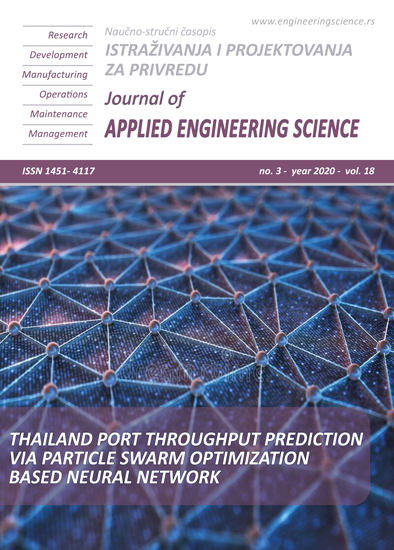AN EMPIRICAL INVESTIGATION OF CUTTING CONDITION ON SURFACE ROUGHNESS IN HARD MILLING OF JIS SKD61 STEEL
Abstract
Surface roughness is an important assessment of metal cutting. This paper presents an empirical investigation of cutting conditions on the surface roughness in hard milling SKD61 steel. The cutting speed, feed rate, depth of cut, and nanoparticle concentration were taken as the parameters in experimental setup. The mixer of SiO2 particles with a size of 100nm based on cutting oil CT232 was used with 3 levels of concentration: 0, 2, and 4wt%. Twenty-seven experiments were carried out based on the DOE method developed by G. Taguchi. The best model from response surface methodology (RSM) was developed regarding the surface roughness. Further analysis with ANOVA method was performed to confirm the significant of the achieved model as well as machining parameters. According to experiment results, the weight percent of nanoparticles concentration had a great impact on the surface roughness, only after the feed rate. Additionally, the excellent effectiveness in reducing the roughness of MQL nanofluid has been demonstrated when compared with conventional MQL.
References
[2] T.-V. Do and Q.-C. Hsu, "Optimization of minimum quantity lubricant conditions and cutting parameters in hard milling of AISI H13 steel," Applied Sciences, vol. 6, p. 83, 2016.
[3] É. M. Arruda, A. P. de Paiva, L. C. Brandão, and J. R. Ferreira, "Robust optimisation of surface roughness of AISI H13 hardened steel in the finishing milling using ball nose end mills," Precision Engineering, vol. 60, pp. 194-214, 2019.
[4] J. P. Davim, Machining of hard materials: Springer Science & Business Media, 2011.
[5] A. Jain and V. Bajpai, "Introduction to high-speed machining (HSM)," in High Speed Machining, ed: Elsevier, 2020, pp. 1-25.
[6] T.-V. Do and N.-A.-V. Le, "Optimization of surface roughness and cutting force in MQL hard-milling of AISI H13 steel," in Advances in Engineering Research and Application: Proceedings of the International Conference, ICERA 2018, 2019, pp. 448-454.
[7] T.-V. Do, "Empirical model for surface roughness in hard milling of AISI H13 steel under nanofluid-MQL condition based on analysis of cutting parameters," Journal of Mechanical Engineering Research and Developments, vol. 43, pp. 89-94, 2020.
[8] T. V. Do, Q. M. Nguyen, and M. T. Pham, "Optimization of Cutting Parameters for Improving Surface Roughness during Hard Milling of AISI H13 Steel," in Key Engineering Materials, 2020, pp. 35-39.
[9] X. Bai, C. Li, L. Dong, and Q. Yin, "Experimental evaluation of the lubrication performances of different nanofluids for minimum quantity lubrication (MQL) in milling Ti-6Al-4V," The International Journal of Advanced Manufacturing Technology, vol. 101, pp. 2621-2632, 2019.
[10] M. P. Suarez, A. Marques, D. Boing, F. L. Amorim, and Á. R. Machado, "MoS2 solid lubricant application in turning of AISI D6 hardened steel with PCBN tools," Journal of Manufacturing Processes, vol. 47, pp. 337-346, 2019.
[11] P. Patole and V. Kulkarni, "Experimental investigation and optimization of cutting parameters with multi response characteristics in MQL turning of AISI 4340 using nano fluid," Cogent Engineering, vol. 4, p. 1303956, 2017.
[12] R. Bag, A. Panda, A. K. Sahoo, and R. Kumar, "A brief study on effects of nano cutting fluids in hard turning of AISI 4340 steel," Materials Today: Proceedings, 2020.
[13] Ç. V. Yıldırım, M. Sarıkaya, T. Kıvak, and Ş. Şirin, "The effect of addition of hBN nanoparticles to nanofluid-MQL on tool wear patterns, tool life, roughness and temperature in turning of Ni-based Inconel 625," Tribology International, vol. 134, pp. 443-456, 2019.
[14] R. Rosnan, M. N. Murad, A. I. Azmi, and I. Shyha, "Effects of minimal quantity lubricants reinforced with nano-particles on the performance of carbide drills for drilling nickel-titanium alloys," Tribology International, vol. 136, pp. 58-66, 2019.
[15] A. A. Sarhan, M. Sayuti, and M. Hamdi, "Reduction of power and lubricant oil consumption in milling process using a new SiO 2 nanolubrication system," The International Journal of Advanced Manufacturing Technology, vol. 63, pp. 505-512, 2012.
[16] S. Roy, R. Kumar, A. K. Sahoo, and R. K. Das, "A brief review on effects of conventional and nano particle based machining fluid on machining performance of minimum quantity lubrication machining," Materials Today: Proceedings, vol. 18, pp. 5421-5431, 2019.
[17] K. A. Osman, V. Yılmaz, H. Ö. Ünver, U. Şeker, and S. E. Kiliç, "Slot milling of titanium alloy with hexagonal boron nitride and minimum quantity lubrication and multi-objective process optimization for energy efficiency," Journal of Cleaner Production, p. 120739, 2020.
[18] R. Kumar, A. K. Sahoo, P. C. Mishra, and R. K. Das, "Influence of Al 2 O 3 and TiO 2 nanofluid on hard turning performance," The International Journal of Advanced Manufacturing Technology, vol. 106, pp. 2265-2280, 2020.
[19] Z. Said, M. Gupta, H. Hegab, N. Arora, A. M. Khan, M. Jamil, et al., "A comprehensive review on minimum quantity lubrication (MQL) in machining processes using nano-cutting fluids," The International Journal of Advanced Manufacturing Technology, vol. 105, pp. 2057-2086, 2019.
[20] H. Hassanpour, M. H. Sadeghi, A. Rasti, and S. Shajari, "Investigation of surface roughness, microhardness and white layer thickness in hard milling of AISI 4340 using minimum quantity lubrication," Journal of Cleaner Production, vol. 120, pp. 124-134, 2016.
[21] S. Khandekar, M. R. Sankar, V. Agnihotri, and J. Ramkumar, "Nano-cutting fluid for enhancement of metal cutting performance," Materials and Manufacturing Processes, vol. 27, pp. 963-967, 2012.

